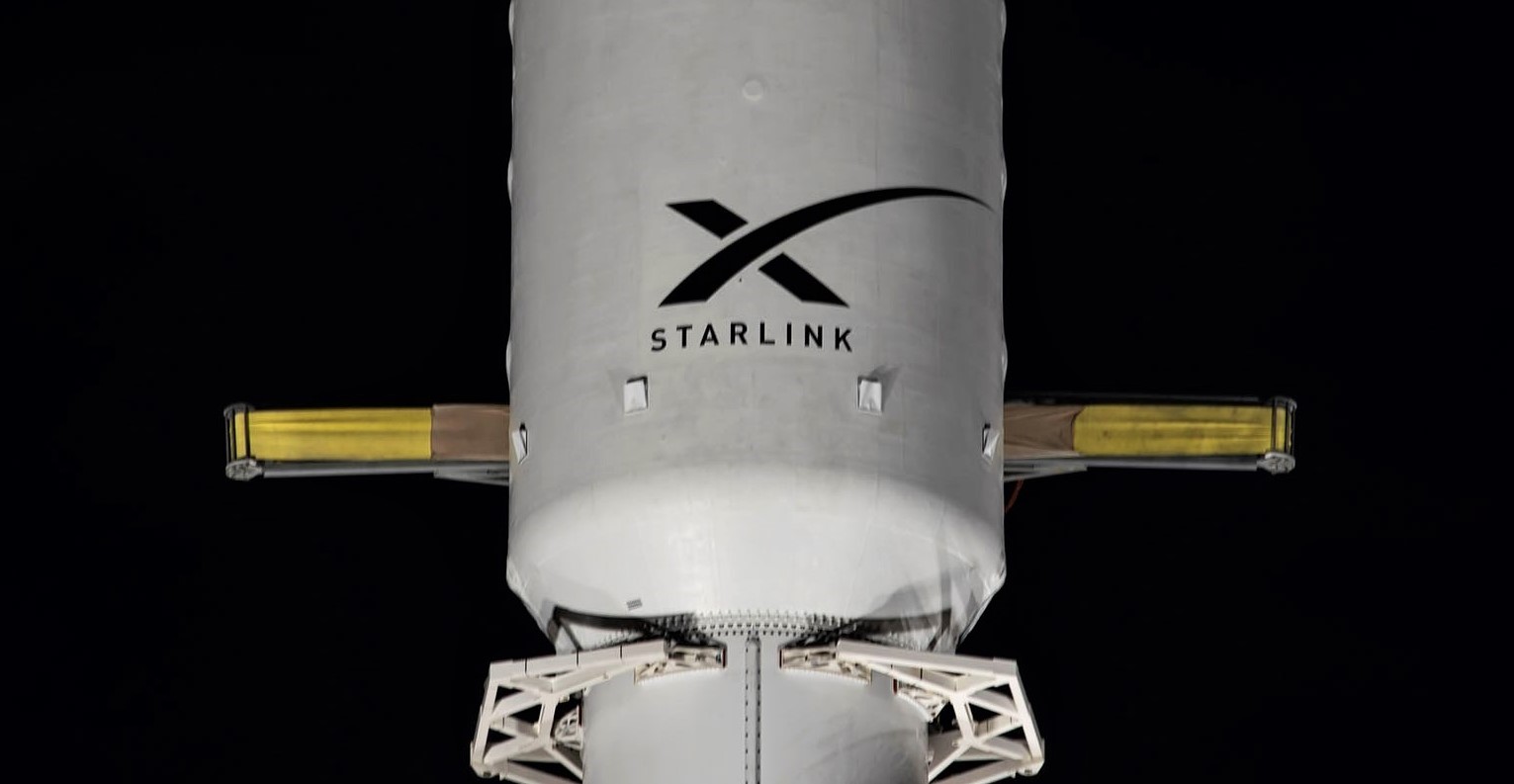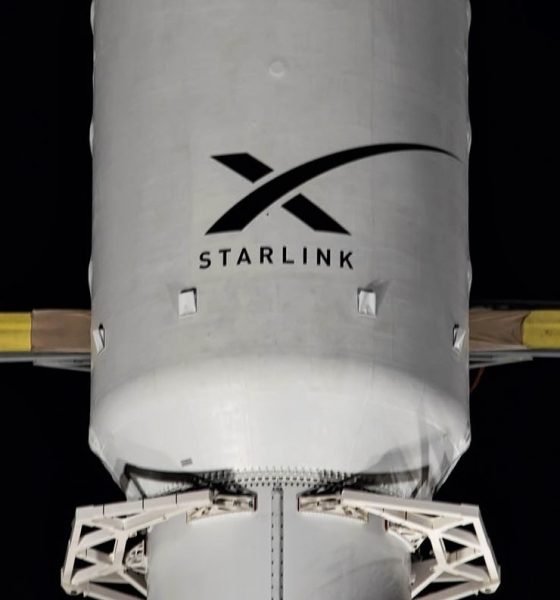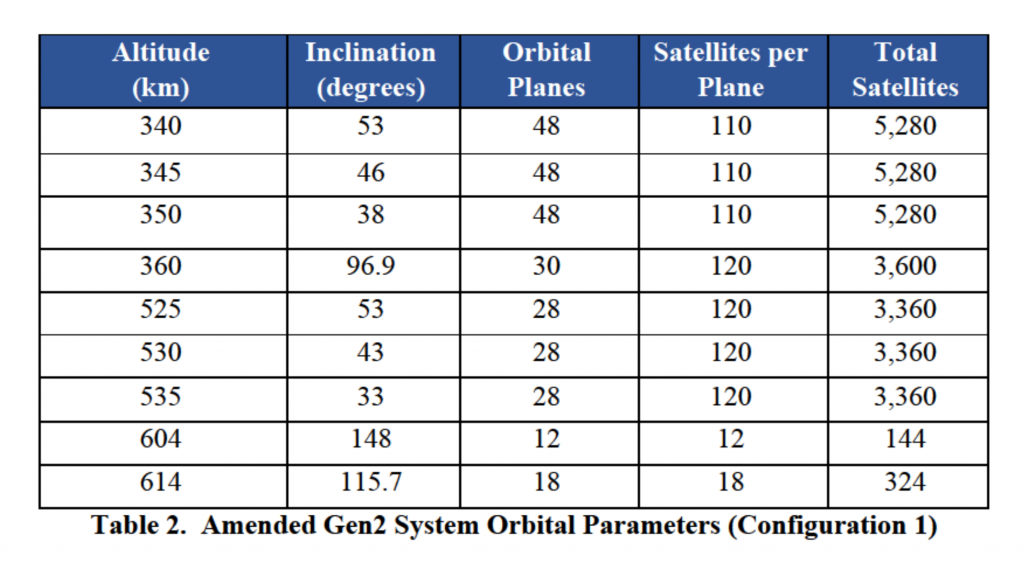

News
SpaceX Starlink Gen2 constellation weakened by “partial” FCC grant
More than two and a half years after SpaceX began the process of securing regulatory approval for its next-generation Starlink constellation, the US Federal Communications Commission (FCC) has finally granted the company a license – but only after drastically decreasing its scope.
In May 2020, SpaceX filed its first FCC license application for Starlink Gen2, an upgraded constellation of 30,000 satellites. In the second half of 2021, SpaceX amended its Starlink Gen2 application to take full advantage of the company’s more powerful Starship rocket and further improve the constellation’s potential utility. Only in December 2021 did the FCC finally accept SpaceX’s Gen2 application for filing, kicking off the final review process.
On November 29th, 2022, the FCC completed that review and granted SpaceX permission to launch just 7,500 of the ~30,000 Starlink Gen2 satellites it had requested permission for more than 30 months prior. The FCC offered no explanation of how it arrived at its arbitrary 75% reduction, nor why the resulting number is slightly lower than a different 7,518-satellite Starlink Gen1 constellation SpaceX had already received a license to deploy in late 2018. Adding insult to injury, the FCC repeatedly acknowledges that “the total number of satellites SpaceX is authorized to deploy is not increased by our action today, and in fact is slightly reduced.”
The update that's rolling out to the fleet makes full use of the front and rear steering travel to minimize turning circle. In this case a reduction of 1.6 feet just over the air— Wes (@wmorrill3) April 16, 2024
That claimed reduction is thanks to the fact that shortly before this decision, SpaceX told the FCC in good faith that it would voluntarily avoid launching the dedicated V-band Starlink constellation it already received a license for in order “to significantly reduce the total number of satellites ultimately on orbit.” Instead, once Starlink Gen2 was approved, it would request permission to add V-band payloads to a subset of the 29,988 planned Gen2 satellites, achieving a similar result without the need for another 7,518 satellites.
In response, the FCC slashed the total number of Starlink Gen2 satellites permitted to less than the number of satellites approved by the FCC’s November 2018 Starlink V-band authorization; limited those satellites to middle-ground orbits, entirely precluding Gen2 launches to higher or lower orbits; and didn’t even structure its compromise in a way that would at least allow SpaceX to fully complete three Starlink Gen2 ‘shells.’ Worse, the FCC’s partial grant barely mentioned SpaceX’s detailed plans to use new E-band antennas on Starlink Gen2 satellites and next-generation ground stations, simply stating that it will “defer acting on” the request until “further review and coordination with Federal users.”

Throughout the partial grant, the FCC couches its decision to drastically downscale SpaceX’s Starlink Gen2 constellation in terms of needing more time “to evaluate the complex and novel issues on the record before [the Commission],” raising the question of what exactly the Commission was doing instead in the 30 months since SpaceX’s first Gen2 application and 15 months since its Gen2 modification. In comparison, SpaceX received a full license for its 7,518-satellite V-band constellation less than five months after applying. SpaceX’s 4,408-satellite Starlink Gen1 constellation – the first megaconstellation ever reviewed by the modern FCC – was licensed 16 months after its first application and eight months after a modified application was submitted.
Adding to the oddity of the unusual and inconsistent decision-making in this FCC ruling, the Commission openly acknowledges that the idea to grant SpaceX permission to launch a fraction of its Starlink Gen2 constellation came from Amazon’s Project Kuiper [PDF], a major prospective Starlink competitor. The FCC says it agreed with Amazon’s argument, stating that “the public interest would be served by taking this approach in order to permit monitoring of developments involving this large-scale deployment and permit additional consideration of issues unique to the other orbits SpaceX requests.”
The V-band Starlink constellation already approved by the FCC was for 7,518 satellites in very low Earth orbits (~340 km). In the first 4,425-satellite Starlink constellation licensed by the FCC, the Commission gave SpaceX permission to operate 2,814 satellites at orbits between 1100 and 1300 kilometers. Increasingly conscious of the consequences of space debris, which would last hundreds of years at 1000+ kilometers, SpaceX later requested permission in 2019 and 2020 to launch those 2,814 satellites to around 550 kilometers, where failed satellites would reenter in just five years. For unknown reasons, the FCC only fully approved the change two years later, in April 2021.
The “other orbits [requested by SpaceX]” that the FCC says create unique issues that demand “additional consideration” of Starlink Gen2 are for 19,400 satellites between 340 and 360 kilometers and 468 satellites between 604 and 614 kilometers. Starlink satellites are expected to be around four times heavier and feature a magnitude more surface area, but the fact remains that the FCC has already granted SpaceX permission to launch almost 3000 smaller satellites to orbits much higher than 604 kilometers and more than 7500 satellites to orbits lower than 360 kilometers. It’s thus hard not to conclude that the Commission’s claims that a partial license denial was warranted by “concerns about orbital debris and space safety,” and “issues unique to…other orbits” are incoherent at best.
Perhaps the strangest inclusion in the partial grant is a decision by the FCC to subject SpaceX to an arbitrary metric devised by another third-party, for-profit company LeoLabs. In a March 2022 letter, LeoLabs reportedly proposed that “SpaceX’s authorization to continue deploying satellites” be directly linked to an arbitrary metric measuring “the number of years each failed satellite remains in orbit, summed across all failed satellites.” The FCC apparently loved the suggestion and made it an explicit condition of its already harsh Starlink Gen2 authorization, even adopting the arbitrary limit of “100 object years” proposed by LeoLabs.
In other words, once the sum of the time required for all failed Starlink Gen2 satellites to naturally deorbit reaches 100 years, the FCC will force SpaceX to “cease satellite deployment” while it “[reviews] sources of satellite failure” and “determine[s] whether there are any adequate and reliable mitigation measures going forward.” The FCC acknowledges that the arbitrary 100-year limit means that the failure of just 20 Starlink satellites at operational orbits would force the company to halt launches. The Commission does not explain how it will decide when SpaceX can restart Starlink launches after a launch halt. SpaceX must simultaneously follow the FCC’s deployment schedule, which could see the company’s license revoked if it doesn’t deploy 3,750 Starlink Gen2 satellites by November 2028 and all 7,500 satellites by November 2031.
Based on the unofficial observations of astrophysicist Jonathan McDowell, SpaceX currently has more 30 failed Starlink Gen1 satellites at or close to their operational altitudes of 500+ kilometers, meaning that SpaceX would almost certainly be forced to stop launching Gen1 satellites if this arbitrary new rule were applied to other constellations. The same is true for competitor OneWeb, which had a single satellite fail at around 1200 kilometers in 2021. At that altitude, it will likely take hundreds of “object years” to naturally deorbit, easily surpassing LeoLabs’ draconian 100-year limit.
In theory, the FCC does make it clear that it will consider changing those restrictions and allowing SpaceX to launch more of its proposed Starlink Gen2 constellation in the future. But the Commission has also repeatedly demonstrated to SpaceX that it will happily take years to modify existing licenses or approve new ones – not a particularly reassuring foundation for investments as large and precarious as megaconstellations.
Ultimately, short of shady handshake deals in back rooms, the FCC’s partial grant leaves SpaceX’s Starlink Gen2 constellation in an undesirable position. For the company to proceed under the current license, it could be forced to redesign its satellites and ground stations to avoid the E-band, or gamble by continuing to build and deploy satellites and ground stations with E-band antennas without a guarantee that it’ll ever be able to use that hardware. There is also no guarantee that the FCC will permit SpaceX to launch any of the ~22,500 satellites left on the table by the partial grant, which will drastically change the financial calculus that determines whether the constellation is economically viable and how expansive associated infrastructure needs to be.
Additionally, if SpaceX accepts the gambit and launches all 7,500 approved Gen2 satellites only for the FCC to fail to approve expansions, Starlink Gen2 would be stuck with zero polar coverage, significantly reducing the constellation’s overall utility. Starlink Gen2 likely represents an investment of at least $30-60 billion (assuming an unprecedentedly low $1-2M to build and launch each 50-150 Gbps satellite). With its partial license denial and the addition of several new and arbitrary conditions, the FCC is effectively forcing SpaceX to take an even riskier gamble with the billions of dollars of brand new infrastructure it will need to build to manufacture, launch, operate, and utilize its Starlink Gen2 constellation.

News
Tesla FSD fleet is nearing 7 billion total miles, including 2.5 billion city miles
As can be seen on Tesla’s official FSD webpage, vehicles equipped with the system have now navigated over 6.99 billion miles.

Tesla’s Full Self-Driving (Supervised) fleet is closing in on almost 7 billion total miles driven, as per data posted by the company on its official FSD webpage.
These figures hint at the massive scale of data fueling Tesla’s rapid FSD improvements, which have been quite notable as of late.
FSD mileage milestones
As can be seen on Tesla’s official FSD webpage, vehicles equipped with the system have now navigated over 6.99 billion miles. Tesla owner and avid FSD tester Whole Mars Catalog also shared a screenshot indicating that from the nearly 7 billion miles traveled by the FSD fleet, more than 2.5 billion miles were driven inside cities.
City miles are particularly valuable for complex urban scenarios like unprotected turns, pedestrian interactions, and traffic lights. This is also the difference-maker for FSD, as only complex solutions, such as Waymo’s self-driving taxis, operate similarly on inner-city streets. And even then, incidents such as the San Francisco blackouts have proven challenging for sensor-rich vehicles like Waymos.
Tesla’s data edge
Tesla has a number of advantages in the autonomous vehicle sector, one of which is the size of its fleet and the number of vehicles training FSD on real-world roads. Tesla’s nearly 7 billion FSD miles then allow the company to roll out updates that make its vehicles behave like they are being driven by experienced drivers, even if they are operating on their own.
So notable are Tesla’s improvements to FSD that NVIDIA Director of Robotics Jim Fan, after experiencing FSD v14, noted that the system is the first AI that passes what he described as a “Physical Turing Test.”
“Despite knowing exactly how robot learning works, I still find it magical watching the steering wheel turn by itself. First it feels surreal, next it becomes routine. Then, like the smartphone, taking it away actively hurts. This is how humanity gets rewired and glued to god-like technologies,” Fan wrote in a post on X.
News
Tesla starts showing how FSD will change lives in Europe
Local officials tested the system on narrow country roads and were impressed by FSD’s smooth, human-like driving, with some calling the service a game-changer for everyday life in areas that are far from urban centers.

Tesla has launched Europe’s first public shuttle service using Full Self-Driving (Supervised) in the rural Eifelkreis Bitburg-Prüm region of Germany, demonstrating how the technology can restore independence and mobility for people who struggle with limited transport options.
Local officials tested the system on narrow country roads and were impressed by FSD’s smooth, human-like driving, with some calling the service a game-changer for everyday life in areas that are far from urban centers.
Officials see real impact on rural residents
Arzfeld Mayor Johannes Kuhl and District Administrator Andreas Kruppert personally tested the Tesla shuttle service. This allowed them to see just how well FSD navigated winding lanes and rural roads confidently. Kruppert said, “Autonomous driving sounds like science fiction to many, but we simply see here that it works totally well in rural regions too.” Kuhl, for his part, also noted that FSD “feels like a very experienced driver.”
The pilot complements the area’s “Citizen Bus” program, which provides on-demand rides for elderly residents who can no longer drive themselves. Tesla Europe shared a video of a demonstration of the service, highlighting how FSD gives people their freedom back, even in places where public transport is not as prevalent.
What the Ministry for Economic Affairs and Transport says
Rhineland-Palatinate’s Minister Daniela Schmitt supported the project, praising the collaboration that made this “first of its kind in Europe” possible. As per the ministry, the rural rollout for the service shows FSD’s potential beyond major cities, and it delivers tangible benefits like grocery runs, doctor visits, and social connections for isolated residents.
“Reliable and flexible mobility is especially vital in rural areas. With the launch of a shuttle service using self-driving vehicles (FSD supervised) by Tesla in the Eifelkreis Bitburg-Prüm, an innovative pilot project is now getting underway that complements local community bus services. It is the first project of its kind in Europe.
“The result is a real gain for rural mobility: greater accessibility, more flexibility and tangible benefits for everyday life. A strong signal for innovation, cooperation and future-oriented mobility beyond urban centers,” the ministry wrote in a LinkedIn post.
News
Tesla China quietly posts Robotaxi-related job listing
Tesla China is currently seeking a Low Voltage Electrical Engineer to work on circuit board design for the company’s autonomous vehicles.

Tesla has posted a new job listing in Shanghai explicitly tied to its Robotaxi program, fueling speculation that the company is preparing to launch its dedicated autonomous ride-hailing service in China.
As noted in the listing, Tesla China is currently seeking a Low Voltage Electrical Engineer to work on circuit board design for the company’s autonomous vehicles.
Robotaxi-specific role
The listing, which was shared on social media platform X by industry watcher @tslaming, suggested that Tesla China is looking to fill the role urgently. The job listing itself specifically mentions that the person hired for the role will be working on the Low Voltage Hardware team, which would design the circuit boards that would serve as the nervous system of the Robotaxi.
Key tasks for the role, as indicated in the job listing, include collaboration with PCB layout, firmware, mechanical, program management, and validation teams, among other responsibilities. The role is based in Shanghai.
China Robotaxi launch
China represents a massive potential market for robotaxis, with its dense urban centers and supportive policies in select cities. Tesla has limited permission to roll out FSD in the country, though despite this, its vehicles have been hailed as among the best in the market when it comes to autonomous features. So far, at least, it appears that China supports Tesla’s FSD and Robotaxi rollout.
This was hinted at in November, when Tesla brought the Cybercab to the 8th China International Import Expo (CIIE) in Shanghai, marking the first time that the autonomous two-seater was brought to the Asia-Pacific region. The vehicle, despite not having a release date in China, received a significant amount of interest among the event’s attendees.








